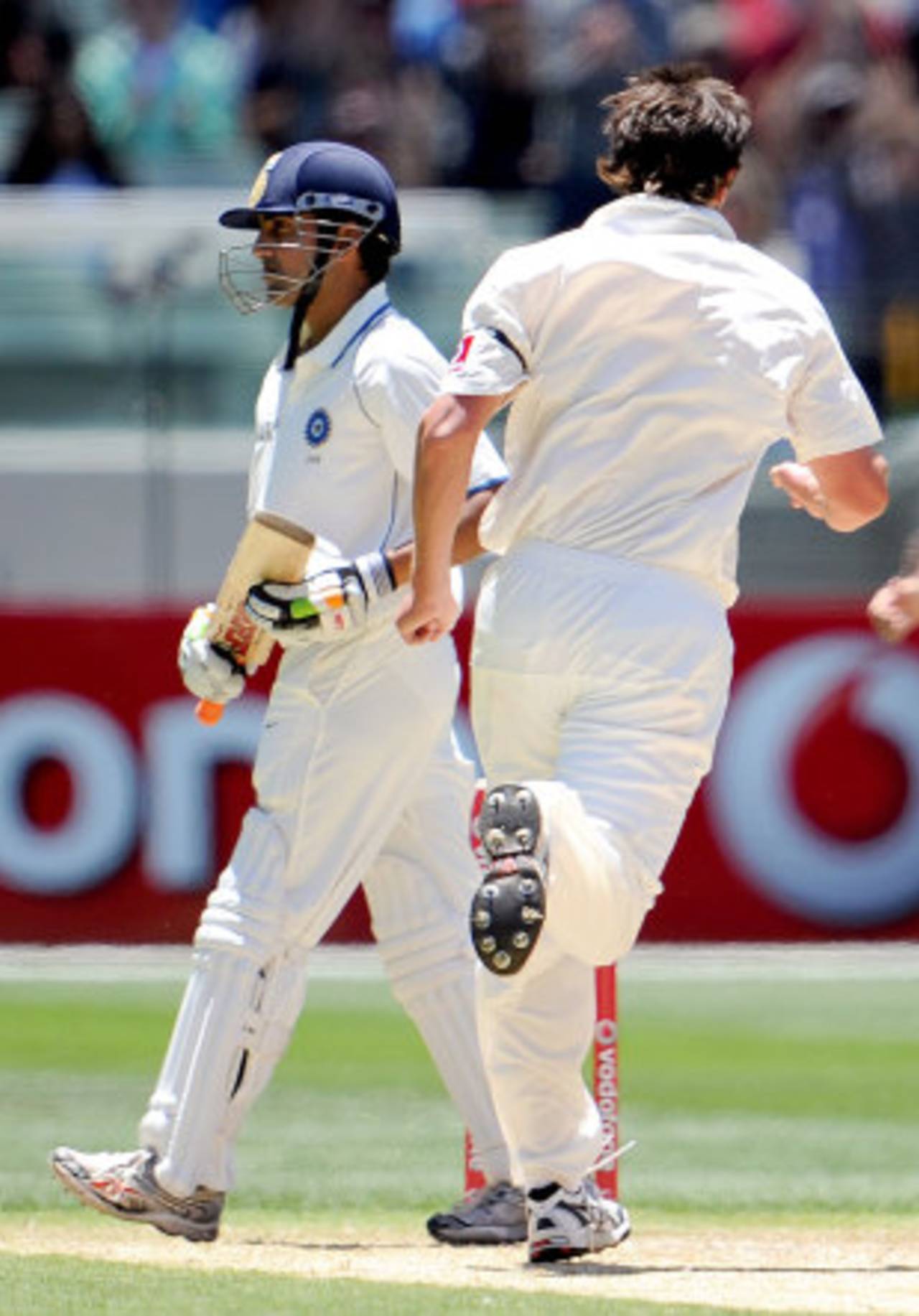Time running out for India
After five straight away losses, India need to turn the trend around sooner rather than later
Sidharth Monga in Sydney
02-Jan-2012

Gautam Gambhir needs to work out how to leave the ball alone • AFP
At the Randwick End of the SCG, at around cow corner, in the first row of where the old Hill would have been, sits a bronze statue of Yabba. It's so well done it's almost alive. Yabba's eyes have squinted, he is in the process of standing up, and his right hand covers the side of his mouth, the way you do when about to shout something to someone far away.
He could well be telling India, who are going through their fielding drills towards the other end of the ground, that if they lose here there is no way back in the series. He would of course use more colourful and inimitable phrases to convey that. That if India lose here, an England-style whitewash is on. Yabba would have found a lot of material to sledge this Indian team with, based on their performance last year.
Last year was the year for landmark wins in Tests. New Zealand beat Australia in Australia for the first time in 26 years. Sri Lanka beat South Africa in South Africa for the first time ever. India's only away win came against West Indies. Eight other away Tests brought them five losses and three draws, two of them in the Caribbean. A year that began promisingly with a drawn series in South Africa and a World Cup win went pear-shaped the moment they landed in England.
All of a sudden, a reputation and a rating built painstakingly - series wins in England, New Zealand and the West Indies; drawn series in Sri Lanka and South Africa; and dominance at home - now has question-marks against it after five straight away losses.
This India team did well despite injuries, despite ordinary preparation, despite poor starts to series, despite poor first innings. Mentally this seemed to be one of India's toughest teams.
It all unravelled in England. They lost at Trent Bridge from a situation much better than those they had been in during some of their previous wins. They failed to draw at Lord's when they should have. England were unrelenting, and India crumbled mentally. The same happened at the MCG. The Indian bowlers had come together, for a change, but there was no relief from any of Australia's quicks, from a side better suited to the conditions and better captained.
These are the times when observers make scathing observations, some of them accurate, some of them a case of reading too much. It is being said the Indians' body language wasn't that of a side keyed up for a tough Test. Wasim Akram has been a critic of the way the Indian fielders don't shout out encouragement to the bowlers, and at such times the criticism becomes sharper. The word "surrender" is often bandied around at such times. Unnamed sources have already started telling newspapers of the discord within the team.
These may be true or not true. If Akram says a loud slip cordon and wicketkeeper matter to a bowler, they probably do. If someone sees passivity in the body language, perhaps there is. However, it is no different than when India are winning Tests. Virender Sehwag has had hands in pockets on cold days both when winning and losing.
Yabba wouldn't have cared much for these observations.
It is the other ones that are more accurate, obvious and far-reaching, and that will need correcting. Gautam Gambhir at the top will have to leave the ball better. The angular bat dab has brought him many runs in the past, it worked even in South Africa when he fended with that angled bat, between perpendicular and horizontal, but it isn't working now. He has edged twice, once well outside off, and once just outside. The bounce is causing trouble, but Ben Hilfenhaus' swing in towards him has made him unsure of the line too. He has to find a way around it. One way could be to leave on a length, which doesn't come naturally to Indian batsmen.
Virender Sehwag will play the way he did at the MCG, and India need him to do so. It's the lack of big scores from Sachin Tendulkar and VVS Laxman that will worry India. All through the year Tendulkar has been in good form for only one century. The same happened at the MCG. Laxman often looked better than his average of 23 in England. Here, denied scoring opportunities early in his innings, Laxman became a little passive. Virat Kohli, who has failed in all of his four away Tests, might be on notice.
Their bowlers, termed by Sehwag the best Indian attack he has played with, will have to find a way to first get into the Australian lower order, and then run through it. It might involve a chat with the captain and the coach to change the strategy, or it might not. They will know, however, that they cannot let the Australian tail outscore theirs.
India do tend to take comfort from the SCG environs, where their batsmen have generally done better than in other venues in Australia. The bounce here is lower, and skiddier, which assists their stroke-play. The pitch starts to break up too. For all that improvement over other grounds, though, they have won only one Test here, that too against the World Series-weakened Australian team in 1977-78.
The other thing about the SCG is the clocks. There is one visible from practically every corner of the ground. At a ground that has embraced past and modernity equally well, you are never unaware of what time it is. India know this is the time to turn things around; time is running out on this particular team, and also this particular series.
Sidharth Monga is an assistant editor at ESPNcricinfo